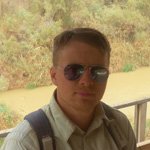2022 Arabian Peninsula
Expedition to the Arabian Peninsula
In 2022 I wanted to organize an expedition that would be a great challenge, a test of perseverance and strength of character. I wanted to travel through selected countries of the Arabian Peninsula, mostly covered by hot desert. I knew it would be hard, lonely and very hot. So I went on a solo journey through the desert of Arabia, although this region also has mountains, canyons, tropical islands, beaches and Arabian culture to offer, among other things. Contact with people who were interested in me and my stories turned out for me to be exceptional, because in that region I didn’t see white people at all. At times I also caused a great stir. For example when in a Saudi village boys shouted “Christian” and they grabbed their heads as if it was the end of the world. However, the people were good and hospitable, as if they wanted to do a good deed in the name of some of the teachings of Islam. My journey was hitchhiking trip, sometimes in the shade of date palms and in the company of camels. ‘Veni, vidi, vici’ – though ‘vici’ was hard for me achieve.
My trip in the Arabian Peninsula
I’ve already written several extensive articles about the Arabian Peninsula but this one will contain some new information, descriptions of interesting places and different photos. I have the Expeditions section on my website, which I made not only for readers but also for me, in order to group what expeditions I have organized over the years. I am publishing this interesting article, which I hope would encourage you to embark on a desert adventure.
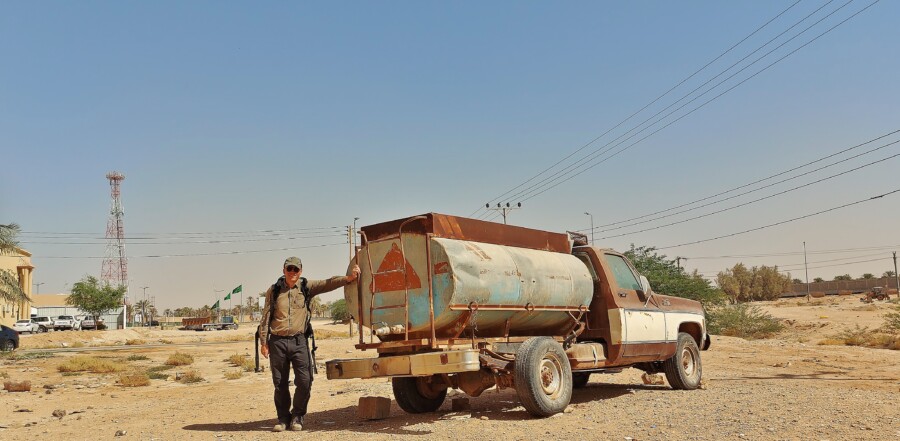
Around Saudi Arabia I travelled with high style. I think even better than millionaires from Dubai. Here I am in Al Jubaylah near Riyadh, which is a place no one has heard of.
As my travel destination I chose Saudi Arabia, Bahrain and Kuwait, even though I had more ambitious plans before the trip. Travelling for two months on a very low budget in those expensive countries, tired and sometimes even exhausted by the desert I just had enough. At the beginning I was deluding myself that I would also go to Qatar, Oman and the Arab Emirates – but I didn’t have enough strength or money. Besides, I had several accidents and I was in two hospitals: in Saudi and in Kuwait. The core of my trip was completely unknown to travellers and very misunderstood Saudi Arabia, while two small countries turned out to be very interesting destinations enriching my worldvie.
I was planning to go to other countries too but before the trip I didn’t realize that Saudia would require that much strength and stubbornness from me. I didn’t have a moment of luxury during this whole trip… but I saw everything. I will always remember the vast sands of Arabia as a time of hardship and sacrifice. (I’m writing this because they’ve seen my site many times and made me look like a millionaire who spent his life on vacation. Well… I didn’t realize that until they told me.)
Many people probably wonder: ‘Why do I even want to go to the Arabian Peninsula when millions of Muslims and thousands of mosques are already in Europe and we are sick and tired of them.’ I assure everyone that I perfectly understand this sober point of view, but on the other hand let’s not let those who destroy Europe with mass immigration also destroy our need to discover the world. In Arabia there is no ‘Divide and Conquer’ war strategy because they are all Arabs.
Here it is about a beautiful adventure that is unreal for ordinary people to imagine. It is important to explore the world and educate yourself that way. I’ve noticed many times that a given country and its people are portrayed in a certain way in Western media, and during my trips I see that the truth is completely different. A good example is Iran, which I liked very much but the Arabs don’t like it all. Propaganda is therefore ubiquitous and I assure everyone that after travelling around 50 countries I see how much political hypocrisy there is in the world.
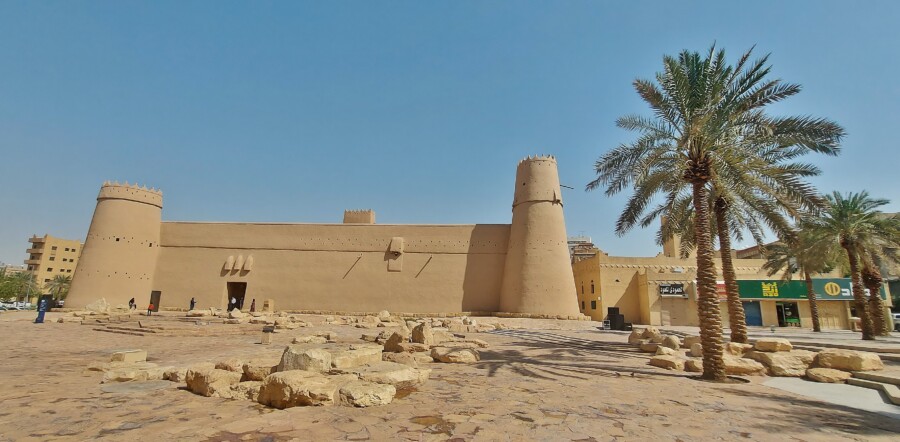
Masmak Fortress in Riyadh where you can see many interesting things about the history and culture of Saudi Arabia. One of them is the way of growing and brewing Arabic coffee. There are many spectacular forts in the Saudi desert.
Besides, the Arab culture is not only limited to Islam! Living in a tent is a part of the Arab tradition because goat and camel herders have lived in the desert for centuries in tents, hiding from the scorching sun under date palm trees. Today, despite the riches of this petrol-region and despite modern technology, living in tents and organizing picnics in the deserts is very popular among Arabs. In some places it is also possible to try falconry, camel riding, or even ride off-road vehicles in sand dunes. One of the interesting aspects of it is brewing Arabic coffee and serving it with dates.
I however did not intend to become the Lawrence of Arabia, because despite my love of travel I have a strong national identity. I just wanted an Arabian adventure that can be experienced in many ways in many Arab countries. For example Jordan was great … and much cheaper than the Arabian Peninsula. There are also Egypt, Palestine, Lebanon and many other interesting countries. Is travel only for the rich?
Dubai – a false image of the Arabian Peninsula
In 2022 I didn’t go to Dubai but I will still mention this unique city because I don’t want the Arabian Peninsula to be associated only with Dubai. This is just one commercial, almost unreal city that does not reflect the tradition of the region. Fortunately there is also an old part of Dubai where on the outskirts one can also see traditional Arab architecture, wooden boats and camels in the desert, but Dubai is advertised as a playground for the rich. Someone who has only been to Dubai has no idea what the Arabian Peninsula is and how interesting and spectacular places this region has to offer. Someone who’s only been to Dubai will never have any idea about the true mentality of the people of the Arabian Peninsula and about its history, and wouldn’t experience the adventure I made.
It makes me laugh when I see self-proclaimed celebrities taking pictures of themselves in front of luxury hotels and luxury cars. It doesn’t impress me at all; because maybe I’m too modest. In Dubai I slept on the beach. During this trip I sometimes slept with camels in the desert and mostly moved around in old trucks. Judging the entire region of Arabian Peninsula through the lens of Dubai is like judging the United States through the lens of Disneyland.
Climate in the Arabian Peninsula
I purpousely started my trip in October because it was cooler. The Arabian Peninsula has the highest temperatures in the world, and in the Saudi desert or in Kuwait they reach up to about 55°C. Europeans cannot imagine it. In a hot dry climate, without wind and without moisture from the sea or river, life is impossible even for the local Arabs. That is why during the summer months life in the Arabian Peninsula starts after dark and all buildings are air-conditioned.
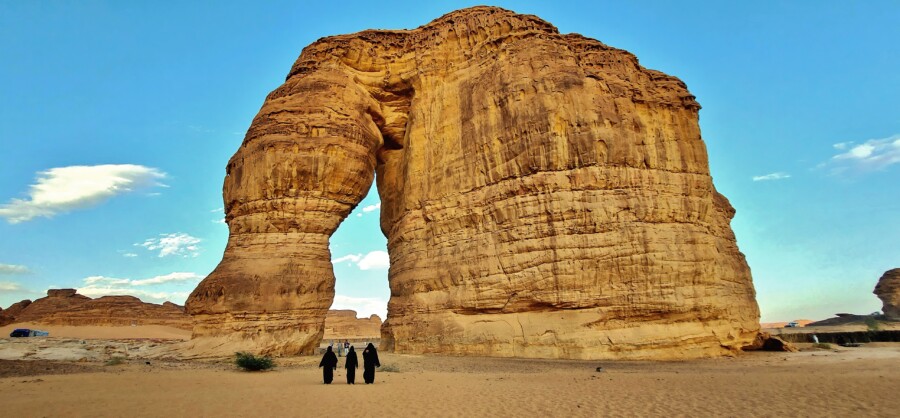
Elephant Rock near Al Ula is one of my favourite places in Saudi Arabia.
I was in Dubai before in August but I was so hot that I left earlier because I couldn’t stand it. The average temperature in October in the Muslim holy city of Mecca in Saudi Arabia is constantly between 30°C and 40°C. For that reason I travelled light and I always had with me the greatest treasure of the desert, which is water. The rush in the desert could prove tragic.
Someone could say that he was in Thailand and it was also 40°C, so I’m probably exaggerating? For that reason I draw my readers’ attention to the huge difference between a hot dry climate and a hot humid one. In Southeast Asia 40°C has friends in the form of a pleasant wind and monsoon rain, while in the Arabian desert there is only a burning fire from the sky that stands still.
I advise future travellers against sunbathing, as they can easily get skin burns. Not because of Islam but because of the climate, I think that visitors should wear long linen trousers, shirts with long sleeves and a collar, and necessarily a hat and glasses. It is also important to use sunscreen number 50 and constantly drink water. The most important thing in a backpack is water, so if there is no room for it, it means that it should be emptied. In a desert water takes on a completely different value.
Due to the hot dry climate I think that white people adapted to low temperatures and rain can go to the Arabian Peninsula from December to January, but taking into account short days in those months, I think that the optimal time is also from October to February. I can take responsibility for this advice. If white people want to go to Kuwait or the Emirates in the spring or summer months, I don’t stop them but in my opinion such people sentence themselves for self-torment. Traveling at this time simply misses the point because the fire from the sky burns mercilessly and for most of the day everything is closed anyway.
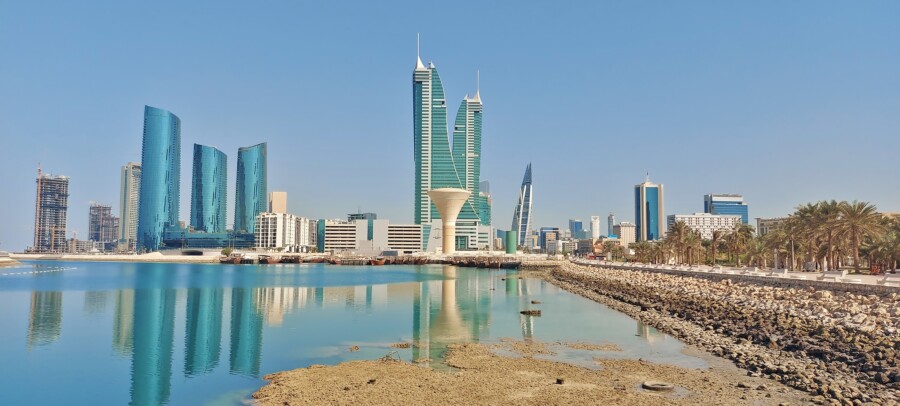
I try to present the Arabian Peninsula as an adventurou region through the hot desert among camels, forts and mosques. However, the Arabian Peninsula is also modern and has views like this; so it’s not only Dubai. This picture shows the promenade on the bay in Manama. Bahrain.
Every year in the Gulf countries about 10,000 construction workers from India and the Philippines die from overwork and heat. One year the temperature in Kuwait reached 50°C, causing birds to drop dead into the desert and seahorses to cook to death in the bay. In the Arabian Peninsula, as in no other region where I’ve been before, climate should be taken very seriously!
Saudi Arabia
As I mentioned earlier, Saudi Arabia was the backbone of my trip. This vast country was a tough challenge but gave me a lot of satisfaction. I can proudly say that my desert trip through Saudia lasted 1.5 months and I got to know this country very well. As for the very few Western travellers who have set foot in Saudi, I want to say that if they just landed in Riyadh and perhaps made a trip to Al Ula, they don’t really know Saudi at all. This country requires time, it requires from travellers to get lost on a desert trail and put an effort in fighting the desert. At this point I suggest one to consider whether you are adventure travellers or just exotic visa collectors.
Typically stereotypes have rational basis, although they are also sometimes prone to exaggeration. Whilst traveling around Saudi Arabia Arabs complained to me about how their country is perceived in the West. They said that: ‘according to Europeans and Americans in Saudi Arabia there are only: ‘desert, camels, Islam and oil’. Besides, the world thinks that apart from those things there is nothing in Saudi at all. Well, the countries of the Arabian Peninsula are indeed the largest producers and exporters of oil in the world, and 95% of Saudi Arabia is covered by desert, which is home to 1.6 million camels. Also, despite several places and landscapes that differ from the traditional image of Saudi Arabia, the stereotypes in this case are indeed true. This however should not be taken as a complete character of the country because apart from stereotypes, many fascinating experiences and outdoors await for us in Saudi.
“Truth is possible only through personal knowledge of countries, while knowledge through the prism of the media will always be a lie aimed at shaping public opinion in order to control the masses.”
Soon I found out that apart from the desert Saudi Arabia also has picturesque valleys and spectacular mountains similar to those in Utah in the USA. Saudia also has ancient tombs and old desert-coloured forts, some pretty beaches, old towns and interesting traditional bazaars. In Saudia I also saw banana plantations and even waterfalls. Besides, different regions of Saudi have their own local cultures and people live a little differently.
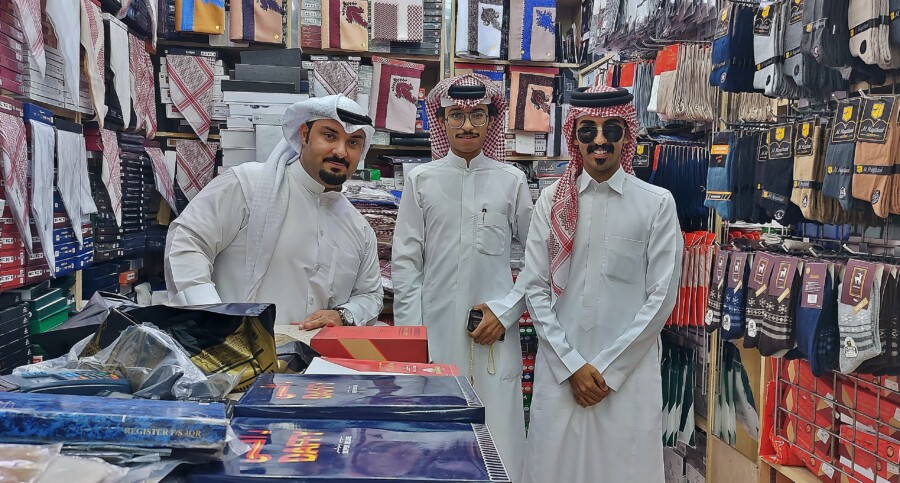
Arabs at the Mubarakiya market in Kuwait. In my opinion it is a very good place to get to know the culture of Kuwait. What I like about the countries of the Arabian Peninsula is that Arabs have great attachment to their traditions. Nobody is forcing them to change. I respect that.
A fuller description of the places I saw in Saudi Arabia I’ve already described in the article: “Saudi Arabia and the passion of travel”, that’s why in this summary I will only mention some places. In addition, I also divided Saudi Arabia into tourist regions, which you can read about in the article “Expedition to Saudi Arabia 2022”. I realize that hardly anyone is as dedicated to travelling as I am and that they also don’t have as much time. As I said, Saudi Arabia takes time but there are some places that must be seen.
I started my journey in Jeddah, which I consider to be the cultural capital of Saudi Arabia. The capital of Saudi – Riyadh is also interesting, although for me the places around Riyadh turned out to be even more interesting. Among other things I organized a trip through the desert to the ‘Edge of the World’ and I rode on red dunes in the company of white camels. I also recommend the historic Dariya old town, which when I was in Saudi was just being prepared for tourists.
In Saudi Arabia there are also picturesque landscapes and attractive natural places which rather match other parts of the world. In my opinion it is primarily the charming canyon of Wadi Lajab where there are big red rocks, bodies of water and even a waterfall to which I jumped from the rope. Incredibly in Saudi Arabia on Farasan island there is also a mangrove forest with pelicans living there. It is however a different mangrove forest than those which I saw in Thailand or Brunei.
There are also of course picturesque places in Saudi that are attractive and do match the image of Saudi Arabia. One such place is Al Habala Canyon, a breathtaking long cliff with a seasonal waterfall. I personally compare Al Habala canyon to Jebel Shams canyon in Oman, but someone might disagree? Another canyon worth recommending is Al Disah, often called the ‘most beautiful canyon of Saudi Arabia’. It is quite a narrow valley surrounded by high red mountains. A stream flows in the middle and there are tall grasses there. The whole of Al Disah and the area around it is a combination of a picturesque desert with attractive mountains. As usual in Saudi, the only problem is getting to all these wonderful places.
Let us also remember that Saudi Arabia is surrounded by the Red Sea and the Persian Gulf and therefore Saudia has many nice beaches, although of course it is not another Thailand, the Philippines or Maldives. My favourite beach was the one in Khafji, 5km from Kuwait. I slept there in a tent and witnessed Arab fishermen pulling interesting fish out of the sea.
Don’t miss Saudi cultural villages, such as Rijal Alma in the Aris Mountains. There is also the beautiful fortified Thee Ain, surrounded by a banana plantation, where there is a waterfall and nerve-wracking baboons. There are also interesting cultural villages around the city of Abha, such as the increasingly popular Al Yanfa village with old houses where people still live and have their flocks of sheep. I was also impressed by the mountain town Fayfa, and the mountain trip near Bani Malek.
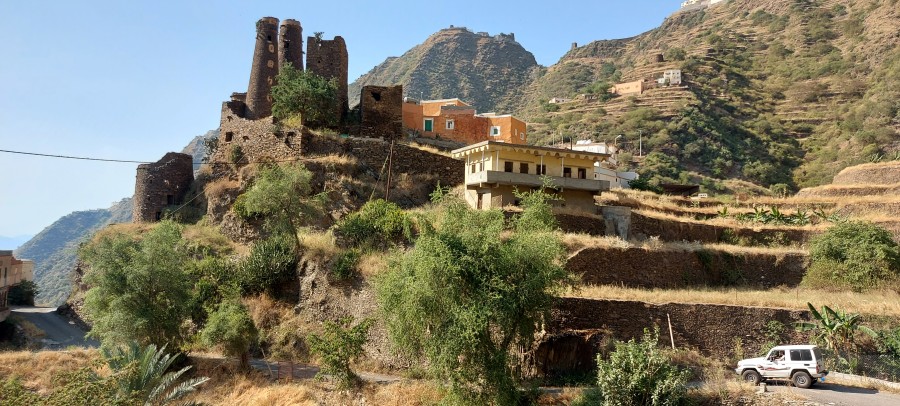
Mountain trip to Bani Malek. Saudi serpentines, ruins of a castle and wild camels along the way. Has anyone been there?
Of course there are also mosques in Sadi Arabia. Some of them are built along seaside promenades, among palm trees and are enriched with Islamic art. (All of this is beautiful, but do I need a mosque in London?) In terms of learning about Islam I went much further because I went to Medina, considered the second holiest place in Islam. (I will add that the Arabs do not want churches in their country, and they are right.) The Medina was a valuable cultural experience!
I could list all those places for a long time, that’s why at the end of my description of Saudia I will mention a place which for a good reason is considered the most beautiful tourist attraction of Saudi Arabia, which is not related to Islam. Of course I’m talking about Al Ula, an ancient town showing how people lived in the desert thousands of years ago. Around Al Ula there is a desert, spectacular rock formations, plantations of bananas, dates, orange trees and other fruits. This only proves that Saudia is developing for the better and that Arabs carry out difficult projects in their desert which are seemingly easy for Europeans.
Near Al Ula there is also Hegra in the desert where there are ancient tombs carved in the rocks, which are a reminder of the Nabataean civilization. I am returning here with my memories to Petra in Jordan. Other valuable places include De Dan and the very attractive Elephant Rock, which is well developed for tourism.
Saudi Arabia has a lot to be proud of! I remind however, that the desert and camels are also very important.
Bahrain
I admit that as for such a very small country Bahrain has a lot to offer. In Bahrain I saw the Manama old town with attractive Arabian bazaar and several impressive forts, that made a great impression on me. The best known is the Portuguese Bahrain fort but there are other ones like Riffa fort and Arad near the airport.
Bahrain also has many nice beaches and islands. In Bahrain the beaches are better prepared than in Saudi Arabia. On one of them I saw flamingos. I noticed that some beaches in Bahrain are for swimming and others serve as playgrounds and food booths that come to life after the heat subsides.
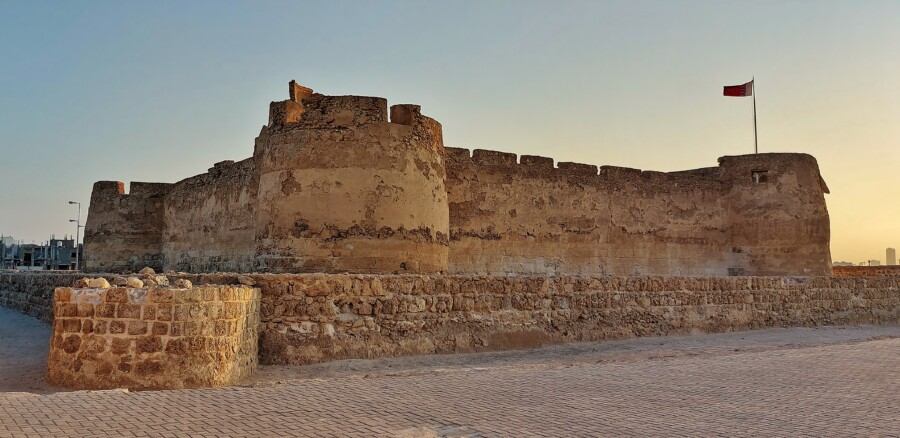
I really liked the impressive Arad Fort, even though it exists in the shadow of other forts. It is close to the airport. I recommend.
Close to Al Jazair beach there is a Formula 1 race track. I think it’s worth it even though access is very limited. I saw the racetrack and I was in the Formula 1 store. In the same area there is also the Al Arin Nature Park which I highly recommend to all nature lovers.
Interesting in Bahrain was also a camel farm near fields and palm trees, seaside promenades as well as good cuisine and milk tea. The people were good, sometimes they let me hitchhike and they were also curious about what I thought about their country.
I also really enjoyed the historic former capital of Bahrain Muharraq, the attractive bridge with Arab boats and the fishing beach overlooking the financial centre of Manama. Before the bridge, towards Muharraq, there is also an interesting Bahrain National Museum.
Between Manama and Muharraq is the Koran Museum, which houses very old and well-preserved versions of the holy book of Islam. Some are huge and others are the size of a fist. I think they are woth attention and admiration because of islamic art and calligraphy, which I had previously seen in a museum dedicated to the same topic in Iran. Also architecturally and culturally attractive was Al Fateh, the largest mosque of Bahrain.
I believe that one should also visit the Tree of Life, which is located in the oil fields of Bahrain and which, despite many studie is still a mystery to scientists. No one is able to answer the question where this tree sitting on oil gets its life. I organized this trip in a great but poor style. I got there by hitchhiking, I started a fire, set up a tent and stayed over night. When the fire went out the night in the desert was cold.
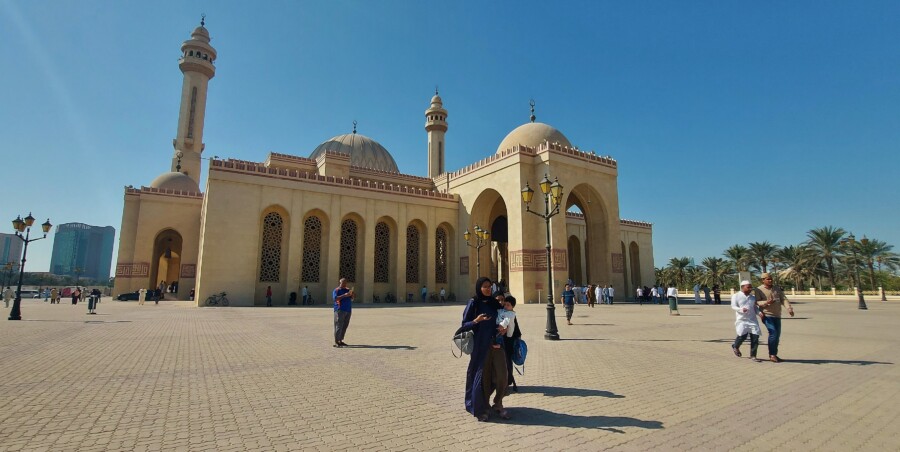
I really liked the Al Fateh Mosque. Bahrain.
I never expected that Bahrain, a country that is over 2.5 times smaller than Riyadh or almost 4.5 times smaller than Muscat would be so attractive for tourists. I am happy that I took the trouble to explore this ‘very little treasure of the Persian Gulf’. More interesting information about Bahrain can be found in the article entitled “Trip to Bahrain”.
Kuwait
Kuwait was my last country during this trip. I was tired of the desert, tired of the heat, tired of hitchhiking and discomfort, and tired of the prices. But I wanted to make one last effort in a new country, and Kuwait turned out to be a very good choice. Kuwait is much larger than Bahrain but the places of interest are very close to each other and there is also less to see for travellers than in Bahrain or the UAE.
Please don’t misunderstand me. Kuwait is also interesting and turned out to be a successful adventure but with my experience in Arab countries there were things that I had already experienced. In Bahrain I saw many forts, that’s why I didn’t want to go through the Kuwaiti desert to the Al-Jahra oasis to see the Red Fort. On the way from Saudi Arabia I also passed near the Al-Wafrah farm, but I had seen fruit farms in the hot desert before in Saudi and Bahrain. Still, I mention these places because if someone has their own transport and a tent, I recommend it. (By the way, Muammar Gaddafi also built vegetable and fruit fields in the hot useless desert until the so-called ‘human rights-respecting democratic countries’ killed him and turned Libya into a war zone.)
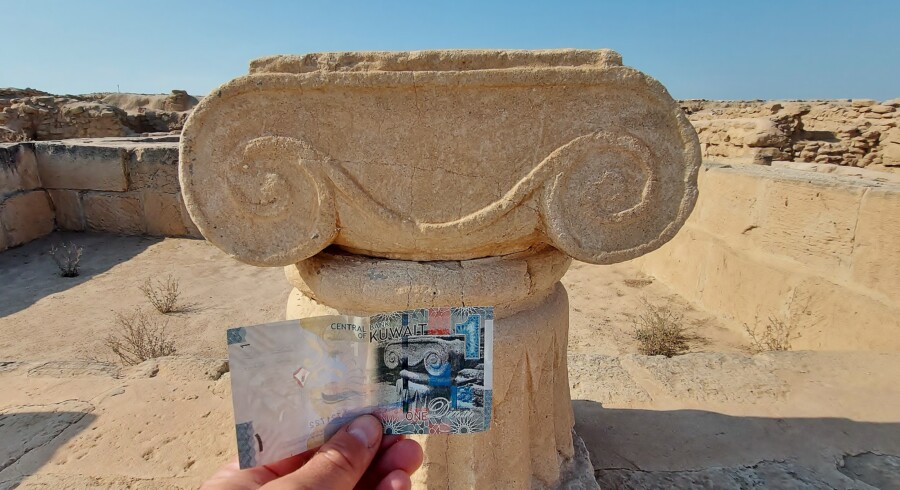
The Greek column on Failaka island is immortalized on the Kuwaiti dinar.
The standard travel route around Kuwait is primarily the capital Kuwait City, and Salmiya which is 11 km away. However, I also took the trouble to go on a one-day trip to the island of Failaka, and on the way from Saudi Arabia I also stopped in the small town of Fahaheel. Usually Kuwait is a transfer place where travellers land for 1-2 days, go to see Kuwait Towers and sit on a hot beach, and then return to the airport.
I must admit that travelling around Kuwait would be much less stressful if not for the cost. Kuwait has the most expensive currency in the world. Well, for 10 Kuwaiti dinars I had to pay as much as 27 British pounds. Food and transportation are reasonably priced for Kuwait but hotels are very expensive. I paid 20 KD and then in a private house for 11 KD. Either way, I could live in Laos or Sri Lanka for that money for maybe a week. Once I tried to sleep on the beach but the security threw me out and transport to the desert is so expensive that it doesn’t pay off.
So what is Kuwait ??? Kuwait is mostly a very hot desert with over 14.5 thousand wild camels. The only exceptions are the small oasis of Al-Jahra at the western end of the Kuwait Bay and a few fertile patches in the southeastern and coastal areas. Kuwait is almost 100% a desert where the temperature in summer reaches up to 50ºC. Kuwait is therefore climatically a very hostile country.
I spent a lot of time in Salmiya on Marina Beach, from which one can see the symbol of Kuwait in the distance: Kuwait Towers. It was very nice there. There is a beach and people swim, and there is also a nice harbour and a promenade on the bay. In Salmiya I also went to the Aquarium which I highly recommend. Later I saw a large mosque with a golden dome. From the port of Salmiya I also sailed to the Failaka island which is a combination of desert nature and history. I enjoyed it all day long, and in the evening I sat on the beach and drank Arabic coffee from a traditional golden jug. Then I also lived in Salmiya.
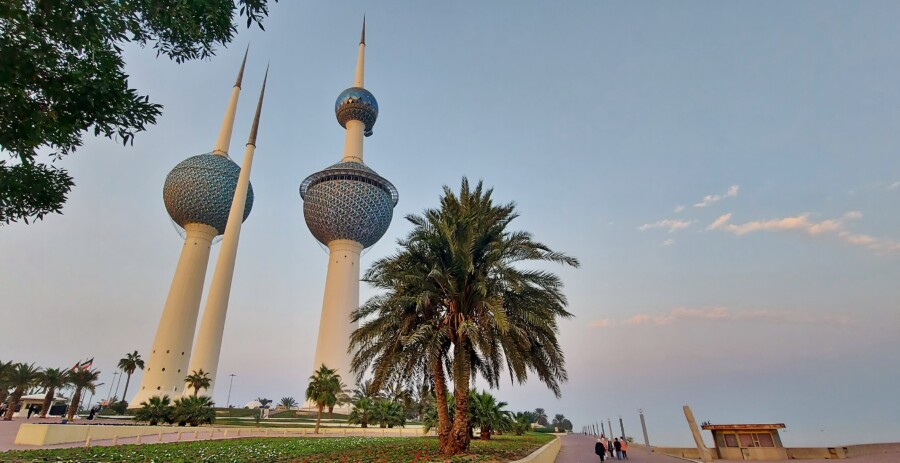
The symbol of Kuwait: Kuwait Towers, which is even depicted on my visa. Kuwait City.
In Kuwait City of course I saw the Kuwait Towers and I took a lift to the top. I walked around the Arabian city and sat under the palm trees. A few times I also returned to the Mubarakiya market where I spent a good time talking to Arabs, tried Kuwaiti cuisine and saw Arab stalls. It was a pleasure to have contact with Kuwaiti Arabs in the teahouse. I tried dates and finally I bought a souvenir from Kuwait. (The local Arabs probably remembered me because just by the Kuwait Towers I lost touch with reality in a very painful way and I was taken away by an ambulance. But that’s not all because other strange and scary things also happened …)
Kuwait definitely deserves attention. Let’s not ignore this country during our travels!
The summary of my desert expedition
I can’t predict the future but I like to think that this quest is not yet finished. After all I was left with Qatar, Oman and the United Arab Emirates. I must rule out Yemen comleptely. The problem here however is the cost, what means that it would be hard to make it quite cheap. For a month of travel in the Arabian Peninsula one could travel for 3 months in the countries of the Indian Subcontinent or Indonesia. The hot dry desert climate is also a problem, but the persistent ones would manage.
Well, I’m happy that I achieved it and I feel fulfilled that I made it despite many problems. I wonder if anyone who has read my travel memoirs slept with camels in the desert and drank milk straight from a camel?
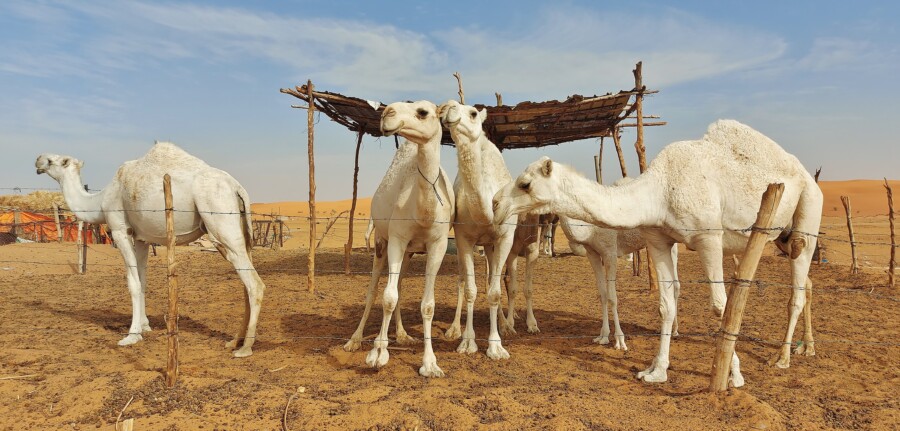
White camel farm near red sand dunes, about 70 km from Riyadh. Saudi Arabia.
- Al Ula Hegra
- Arabian adventure
- Arabian Peninsula travels
- Bahrain Manama Muharraq
- Bahrain travel
- Capital of Kuwait Kuwait City
- Climate in the Arabian Peninsula
- Forts in Bahrain
- is travel only for the rich
- Islam in Arab countries
- Kuwait prices
- Kuwait travels
- Map of Kuwait
- Persian Gulf travels
- Salmiya Kuwait
- Saudi Arabia tourism
- Travels to Arab countries
- Trip to Kuwait
- What to see in Bahrain?
- What to see in Kuwait?
- What to see in Saudi Arabia?



